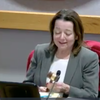To save money Bus study urges changing bell times
To save money
Bus study urges changing bell times
GUILDERLAND Changing bell times when schools start and end their days was the biggest change recommended by a consultant who studied Guilderlands transportation system with an eye to saving funds.
"I don’t want to do it just to save bus money," said school board member Colleen O’Connell, as board members stated their first reactions to the report last Tuesday. O’Connell said the change would have to have "an educational component."
Board Vice President Linda Bakst said she looked at it as a good opportunity "to open that discussion." Several years ago, the board listened to a student’s request to start high school later, and looked at research stating adolescents needed more sleep.
"We’ve heard the evidence on that issue," said Bakst.
The 21-page report prepared by Transportation Advisory Services consultant Christopher Andrews recommends changing the order in which the high-school, elementary-school, and middle-school days begin and end, or lengthening the day for the elementary schools in order allow runs with fewer buses, thereby saving money.
Christine Sagendorf, the districts transportation director, told the board that the department had talked about changing bell times before, especially at the middle school, and had also talked about consolidating bus stops.
She termed them "things the board has to look at."
Assistant Superintendent for Business Neil Sanders, who had recommended hiring Transportation Advisory Services, called the analysis "a helpful process to go through."
He told The Enterprise this week, "the report validates what we’ve done in our transportation department. There are no glaring omissions or weaknesses."
He also said that some of the recommended changes without cost, such as realigning clerical duties or updating software, were likely to be done soon while others would have to wait.
In November, the school board voted to contract with Transportation Advisory Services for a study after comments were made during budget discussions that the district should look at privatization. TAS, based in western New York, founded in 1987, has done transportation studies for over 400 school districts and agencies in 16 states, Sanders told the board. Guilderland paid TAS $9,850 for the 90-day study and report.
Privatization not recommended
In January, officers of the local union that includes bus drivers and mechanics expressed concerns to the school board. President Bruce Shank said the union was hurt by discussions of privatization and that workers give their "heart and soul" to their jobs.
Since learning about the study, Shank said, some of the employees had started seeking other jobs, which could result in a loss of drivers.
He asked why the district would have built a new bus facility two years ago if it planned to move to private contractors.
Shank also pointed to the districts record of 90 percent or more buses passing the required inspection by the states Department of Transportation. He asked how the safety of buses would be affected with others doing the repairs.
"Our current staff is deeply committed to doing the best job possible every day," said Shank.
The TAS report does not recommend general privatization; it does recommend partial contracting.
"Contracting in general is viewed as an option for schools that are having difficulties managing their transportation department," writes Andrews. "In most case, it is a matter of outdated facilities, aging fleets, or labor discord. Guilderland is not faced with any of these challenges."
TAS recommends Guilderland continue to provide transportation for public-school students, but contract out special-needs and non-public runs.
The report also recommends that Guilderland share out-of-district transportation whenever possible, continuing to work with the Board Of Cooperative Educational Services and neighboring school districts.
"For example, Voorheesville might pick up Guilderland students on the way through the district, headed towards a non-public school that serves students from both districts," the report states.
"Where efficiencies cannot be gained by doing this," Andrews writes, "we recommend that the district consider these runs for contracting."
During the 2004-05 school year, Guilderland transported about 5,978 students in kindergarten through 12th grade. About 5,414 were transported to the seven school buildings in the district five elementary schools, a middle school, and a high school while 429 were taken to 35 private or parochial schools and 135 were transported to special-needs facilities. Ninety-three route vehicles were used.
Guilderland also provided a large number of sports and field trips using district-owned vehicles, the report says. These services combined cost the district $6,635,643 for the last school year.
Labor and facility recommendations
The report recommends evaluating other sources of funding for sports and field trips. Like sharing out-of-district runs, this is termed a long-term priority, meaning it would take 31 to 90 days to accomplish.
Andrews reports that sports and field trips cost Guilderland $135,301 last year. "Given that these costs are not eligible for state aid, we recommend that the district evaluate other sources for funding these programs," he writes.
Some districts have booster clubs or parents groups pay for such trips while others have negotiated limits on driver pay for trips, establishing a flat field-trip rate, lower than the regular pay scale, for any work outside the assigned home-to-school runs.
Other labor changes recommended by TAS include: realigning clerical positions, purchasing trip-scheduling software, using monthly activity reports, purchasing a new time clock, and improving driving recruitment by offering referral fees and signing bonuses.
The report also recommends tying maintenance software into the fuel pumps and widening the entrance gate to the bus yard.
Saving money
The TAS report notes the average cost-per-mile for eight surveyed area school districts is $3.09; the average cost-per-student is $617, and the average cost-per-route is $40,299.
Though the report notes that factors like area covered, size and age of fleet, and bell times can vary widely, it states, "But the fact that Guilderland falls on the high side of all of these comparisons is a good indication that there is room for improvement, and implementation of some of the recommendations in this report should result in improved cost control."
Andrews’s report goes on to state, "The ‘easiest’ way (operationally, not politically) to reduce transportation expenses is to reduce services. This can be achieved by requiring students to walk to school up to the maximum allowed by state regulations," which is two miles for elementary and middle-school students and three miles for high-school students.
"Given the size of the district, the lack of sidewalks in many areas, and the high level of service that the parents are accustomed to, this would likely cause quite an uproar," the report concludes.
A similar option is to have fewer bus stops, the report says. Currently, the district’s policy is two-tenths of a mile for its youngest students, a half-mile for those in grades five through eight, and one mile for high school students. "According to state regulations, it is the parents’ responsibility, not the district’s, to ensure that their children get to the assigned bus stops safely," writes Andrews.
Changing bell times
Another option, he writes, is to expand bell times, allowing runs with fewer vehicles.
Currently, district bus routes operate nominally on a three-tiered system. High-school students are in the first tier. Their day begins at 7:30 a.m. and ends at 2:25 p.m. Elementary students are next, starting school at 8:10 a.m. and getting dismissed at 1:55 p.m. Middle-school students are last, starting at 8:50 a.m. and getting dismissed at 3:20 p.m.
Andrews writes of the current schedule, "Tight bell times increase the need for additional buses to complete the routes in less time." He notes that Guilderland has a middle school with one of the latest bell times in the area and that Guilderland’s five elementary schools have the shortest educational day, of five hours and 45 minutes while the average length is six hours and 13 minutes.
Schools in the area with more than 5,000 students like Guilderland, are triple tripped, while those with under 5,000 students are double tripped, says Andrews.
"Although the district considers itself triple tripped," he writes, "the tight bell times...have the effect of negating the cost benefits of triple tripping, because...tight bell time increase the need for additional buses to complete the routes in less time."
Under "true" triple tripping, Andrews writes, the entire fleet makes three trips throughout the district, transporting students in different grade levels at different times.
The reason most schools transport elementary students last in the morning is that the high schools and middle schools are typically zoned district-wide, as they are at Guilderland, meaning that the buses must cover the entire district to pick up students. After completing these runs, the fleet can then be disbursed to the smaller elementary zones to transport their students.
"In Guilderland," Andrews writes, "the buses traverse the entire district for high-school students, then have 40 minutes to separate into the elementary zones, then have 25 minutes to again traverse the entire district for the middle-school students. Given the shortest elementary-school day, in the afternoon, the district is again unique in having the elementary transported first.
"These factors," he concludes, "result in an inefficient use of drivers and vehicle." He recommends that Guilderland use routing software to develop three possible route configurations:
Continued triple tripping with the same length of day, but the order changed to high school, middle school, then elementary schools;
Continued triple tripping with a longer elementary day, with the order changed to high school, middle school, then elementary schools; and
Double tripping by combining grades six through 12 students into one bell time.
"It’s doubtful that double tripping would be the most efficient," Andrews concludes, but it’s worth considering if the first two options can’t be implemented.


